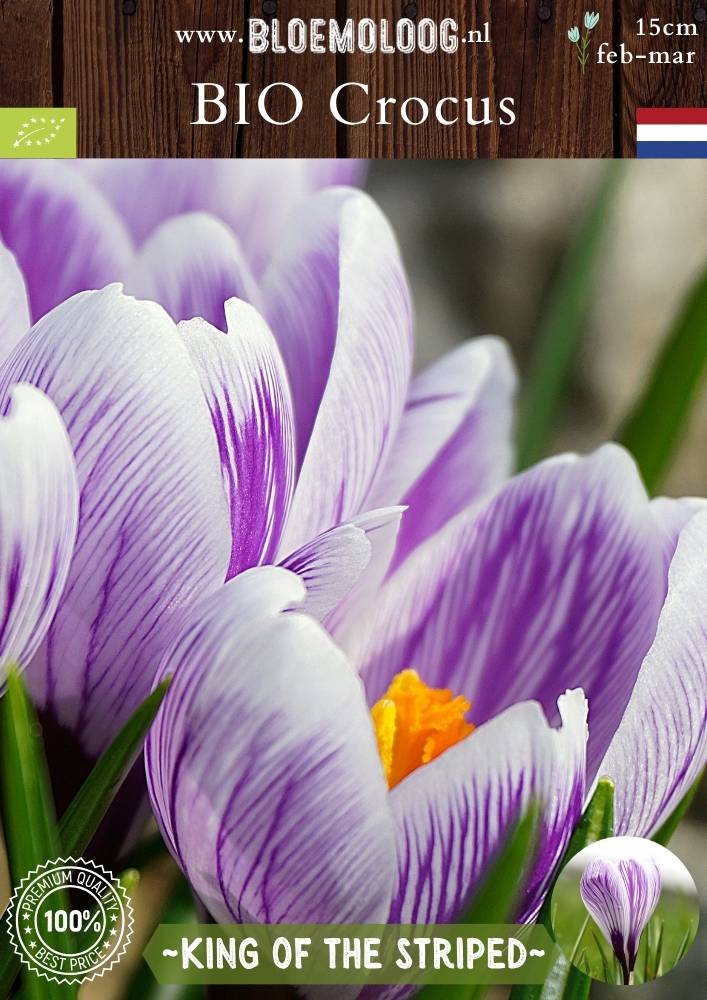Bloemoloog
Organic Crocus vernus 'King of the Striped' - Giant dutch crocus | 10 pcs.
Organic Crocus vernus 'King of the Striped' - Giant dutch crocus | 10 pcs.
Estimated Shipping Widget will be displayed here!
Couldn't load pickup availability
Organic striped crocus
The Crocus vernus 'King of the Striped' is a large-flowered white crocus with a great color pattern with purple veins running from bottom to top on the petals. The flower contains striking orange stamens in which you can see the bees bathing. As soon as the sun shines on her flower, she opens it wide and in the evening the flower closes again. The plant's leaves are 2 millimeters wide and only grow above the flower after flowering and will die naturally in late spring.
The nice thing about the crocus is that it blooms very early in the spring, it blooms in February and March. For example, pollinators such as bees have nectar immediately after the cold winter, so that they become extra powerful for the summer. The Bloemoloog® recommends crocuses to every garden, so we can give the insects a helping hand!
How, where and when do I plant a crocus tuber?
A crocus tuber needs a cold period. Therefore, plant it in the ground in the autumn from October to January. The planting depth is 2 to 3 times the height of the tuber itself and the planting distance is 2 to 3 times the width of the tuber itself. Plant 100 - 120 tubers per m². If they are planted in a pot, there must be holes at the bottom of the pot so that no water remains in the pot, otherwise the tubers will rot.
The ideal location is in full sun or partial shade. Plant it in a nutrient-rich, water-permeable, preferably calcareous, sandy soil. This colorful crocus is suitable for naturalizing in the grass, in the border or under deciduous trees and shrubs. They are also ideal to use as the top layer in a lasagna (3 or 4 layers with balls) pot.
Soil PH: Slightly acidic to neutral.
Care of the crocus
The Crocus 'King of the Striped' naturalizes well, so requires little special attention. It is only important that the leaves are not cut off immediately after flowering. These still take up photosynthesis so that the tuber gathers strength for the next year. The leaves die off on their own. Once the leaves have withered they can be cut off. Provide organic food annually for optimal results.
Crocuses produce one or more new tubers on top of the old tuber. This sometimes causes the tubers to lie above the ground. In that case, plant the tubers back in the ground.
Propagation
For propagation, the tubers can be removed from the ground at the beginning of summer. Dry the tubers and store them in a warm place, for example in the shed. The tubers are replanted in the ground from September.
Origin of the crocus
The variegated crocus is a stinzen plant and has been naturalized in the Netherlands for centuries, but is originally from the southeast of Europe. The Crocus vernus gets its name because it blooms in the spring. Vernus is Latin for; belonging to spring.
Particularities
A crocus comes from a tuberous crop.
Buy Organic Crocus vernus 'King of the Striped'
Skal NL-BIO-01 certified: 109459
Packed per 10 tubers or choose a stacking discount.
Stacking discount: E
Can be ordered from June '25!
EU shipping €8.95 - Free shipping from €100 purchase.
Characteristics
| Flowering time: | February - March |
| Planting time: |
From September |
| Planting depth: |
7 cm deep |
| Planting distance: | 7 cm apart |
| Height: |
15 cm high |
| Flower diameter: | 5 cm wide |
| Location: |
Partial shade, sun |
| Soil PH: | Loam, sandy soil - Slightly alkaline/neutral |
| Winter hardiness: |
Very hardy |
| Propagation: | Good (wild) |
| Family: | Iridaceae (iris family) |
| Colour: | White/purple |
| Bee-friendly: | Yes |
| Fragrant: | Yes |
| Bulb size: | 7+ |
Other crocus species

NL-BIO-01
To share




















